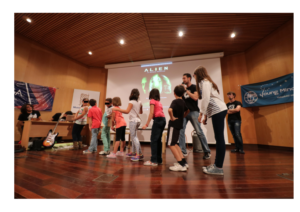The YM Valladolid Section released ‘The Sound of Physics’ on September 30th, 2016 for an audience of 300 people. Performed as the main event of the European Researchers Night 2016 at the Science Museum of Valladolid, its aim was the explanation of mechanical waves, particularly sound, and the characteristics of music. The spectacle was performed once more on November 26th, 2016 at the theater of Renedo de Esgueva (Valladolid) for 200 music students. Children and adults could enjoy and learn what a wave is, its mechanisms of propagation, and its physical properties – wavelength, frequency, amplitude, linear superposition… – together with associated physical phenomena, such as Doppler effect. How do different types of musical instruments produce sound? How can the characteristics of the latter be modified? These are only some of the questions that were answered during this activity. The explanations were accompanied by illustrative experiments, as well as short, but well-known, pieces of music, played by YM Valladolid members.
The first part of the show was mainly devoted to the properties of mechanical waves. To picture them, a variety of resources were used, such as ropes, animations and videos. The public could take part in a simulation of propagation of the sound inside different media, where they were the atoms, and their arms represented the interatomic forces. The audience played with a ball with a buzzer inside, perceiving the Doppler effect. They could also hear a sound produced by a whistle of the London Metropolitan Police, formed as the sum of two tones of frequencies too high for the human ear, and thus living the difference between frequency -physical quantity- and tone -subjective perception. The Rubens tube helped with the introduction of the concepts of stationary wave and resonance.
The second part dealt with the physics of the musical instruments. For percussion, wind, string, electronic and electromechanical instruments the following topics were covered: how the sound is generated, how its qualities can be controlled, and why these qualities are modified in that way. The role of resonance chambers was clarified, using as an example the ‘blasters’ sound production in the Star Wars saga by using a metallic spring and a plastic cup (as it was originally done). The public could agitate balloons with an hexagonal nut inside to understand the sound produced by a membrane instrument, and a Chladni plate helped to visualize it. The instruments used and explained included: glass bottles, ocarina, recorder, transverse flute, ukulele, solid metallic bars, violin, acoustic guitar, electric guitar, theremin and Tesla coil. Timbre was introduced by recording in situ the sound emitted by some of them and by explaining the differences among their waveforms and spectra. The show was enlivened by playing short well-known pieces, like ‘The Lion Sleeps Tonight’, ‘Concerning Hobbits’, ‘Star Wars Cantina’ and ‘We Will Rock You’, counting the latter with the participation of the audience.
After its great acceptance, further repetitions of the show are expected soon.

